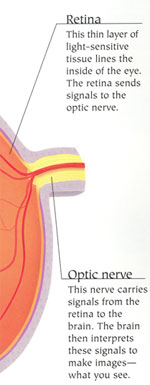Sharp vision depends on many factors. The parts of the eye work together to refract (bend and focus) light rays. For normal vision, light must focus on the retina. If the cornea or the eyeball as a whole is not the right shape, light doesn’t focus correctly, and vision is blurry. Common focusing problems include myopia, hyperopia, and astigmatism.
Turning Light into Sight

| Emmetropia(normal vision) is maintained when light focuses on the retina. |  |
| Myopia (nearsightedness) occurs when light focuses in front of the retina. Distant objects appear blurry. |  |
| Hyperopia (Farsightedness) occurs when light focuses behind the retina. Nearby objects appear blurry. |  |
| Astigmatism occurs when light focuses in more than one place. Both nearby and distant objects are distorted. |  |

If you're Over 40
With age, the eyes lens becomes stiff and can't accommodate easily, causing presbyopia (difficulty focusing on nearby objects). Refractive surgery can't treat presbyopia, so if you're over 40 you may need reading glasses even after surgery. Another option for coping with presbyopia is monovision. To create monovision, refractive surgery is used to adjust one eye for near vision and the other for distance vision. This option is not for everyone, so discuss it with your eye doctor. A trial period of monovision using contact lenses may help you decide if it's right for you.
